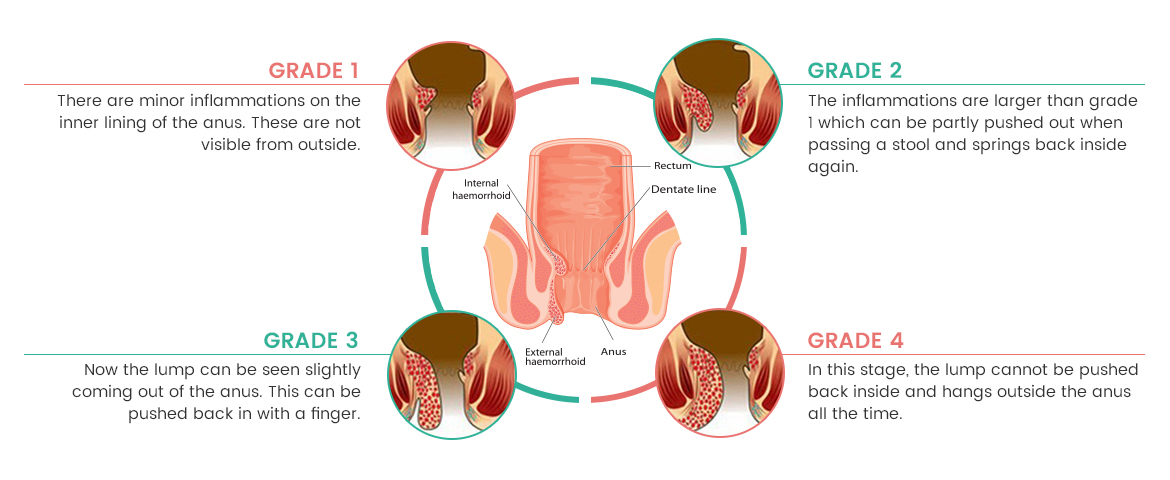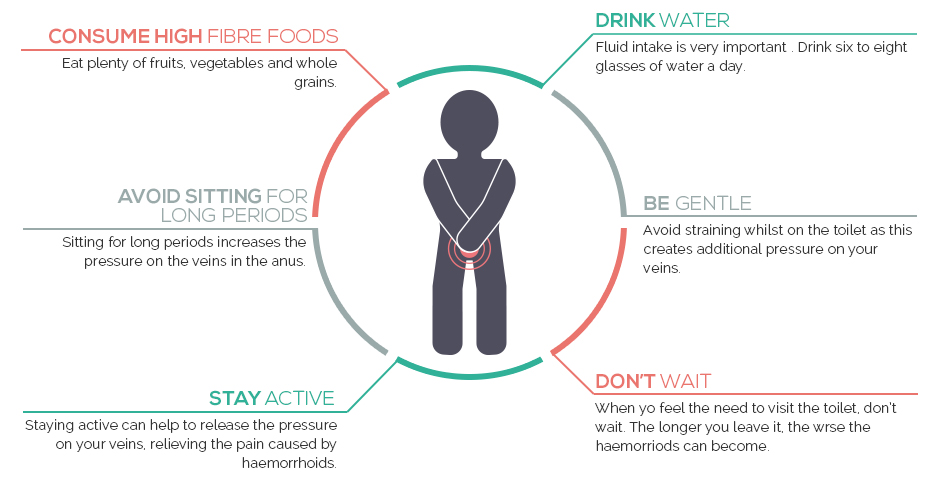What Are Piles?
These are essentially swellings which occur in the anal canal. It can be an incredibly painful condition, and is caused by a variety of factors. You can also feel them hanging outside the anal cavity or in the anus upon touching. In many cases, piles symptoms can be noticeable as soon as onset occurs – but whenever they appear, it's important to remedy the situation as soon as possible.
Types Of Piles
Piles can be of various sizes and may occur either inside the anus or outside the anus. It can therefore be divided into 2 general categories - internal and external.
Internal piles
These are the much more common type of haemorrhoids that are usually painless. It typically occurs from 2 to 4 cm inside the opening of the anus in the upper anal canal which has no pain nerve fibres. Based on the internal piles symptoms, severity and size, it can be further classified into 4 grades:
External piles
On the other hand, this type occurs on the outside edge of the anus, in the lower part of the anal canal. This lower part of the anal canal consists of pain nerve fibres and so the lumps formed in this area are often itchy as well as painful.
How Can You Identify Piles Symptoms?
Haemorrhoids can be so mild that the person with the condition may not even realise they have them. This could be because there may be no symptoms present or symptoms go away on their own in a few days without hurting. This means symptoms of haemorrhoids can vary. Overall, small internal piles are usually painless and larger piles may cause a mucous discharge with some level of pain, irritation, and itch. The most common ones out of the various symptoms an individual may experience include:
What Are The Causes Of Piles?
The most commonly believed cause of haemorrhoids is weakness of the tissues that support the blood vessels in the anal region. The vessels get stretched and become thin which can lead to bleeding. With intra-abdominal pressure they’re displaced downward and result in piles. There are several factors responsible for the development of this condition:
Chronic constipation and diarrhoea
If your bowel movements are harder and drier than normal, you could have constipation. Hard stool causes inward pressure on the haemorrhoids which results in obstruction of blood flow, and outward pressure from the abdominal and pelvic muscles. This straining causes the haemorrhoids to become further inflamed and prolapsed. Here are some remedies to keep constipation at bay.Improper diet
Many dietary choices such as a low fibre diet, spicy foods and alcohol intake could lead you to developing haemorrhoids. There may not be enough research to prove this but if we consider low fibre, its consumption does cause constipation and constipation may lead to piles if you have a history of it. Similarly, spicy food and alcohol too may cause diarrhoea which again is a risk factor.Sitting posture
Piles can be caused by various things, but the most common reason why people get haemorrhoids is due to excess stress from sitting for long hours. This may also include sitting on the toilet for longer periods due to bad diets. Being seated for long may obstruct the blood circulation in the pelvic region causing formation of haemorrhoids.Obesity
There are many health impacts of being overweight or obese and one of them is piles. As you know if you sit for too long or you're not physically active, you may have a greater chance of getting this condition. Being physically active tones and strengthens abdominal muscles and colon walls which can help you prevent the risk of haemorrhoids.Ageing
Haemorrhoids actually have three components- the mucosa lining, the cluster of veins and smooth muscle, and supporting and anchoring connective tissue. So when the anchoring and supporting connective tissue system weakens with age, it can cause the veins to stretch and become swollen. This becomes more sensitive to pressure from straining and worsens the condition.Pregnancy
There are women who complain about having piles during pregnancy. Most often it may be temporary but at times become an ongoing problem. The growing uterus during this period puts pressure on the pelvic veins which might compress it. Another common occurrence during pregnancy is constipation which again worsens the condition.How To Prevent Piles?
Once haemorrhoids occur, they can be incredibly painful and difficult to get rid of – luckily, there are a few things that you can do to prevent future outbreaks: make sure you’re eating a high-fibre diet to prevent constipation, and if you’re in a job which requires you to sit down for long periods, make sure to stand up or go for a walk for at least a few minutes every hour.
Natural Solutions To Get Relief From Piles
In the majority of cases, you don't need to worry much about piles as it may resolve on its own without the need for any treatment. Although, some over-the-counter treatments can help reduce the discomfort and pain due to haemorrhoids that some may experience. There are herbal or botanical medicines which may hold potential to help soothe the situation and some that can help you manage redness and swelling around the anus area.
Piles Creams: Herbs can not only help with some ailments but may also offer more useful properties. This is why nowadays natural remedies are preferred more by people over powerful treatment options for different conditions, including haemorrhoids.
As a direct solution for piles you can go for topical creams or gels available. They’re usually applied on the affected area. It’s always better to apply the cream after having a shower so that it doesn’t get washed off and it’s when your skin pores widen to aid faster penetration. The natural herbs can be soothing for haemorrhoids and your skin.
Piles Capsules: This is also one of the easiest solutions for managing haemorrhoids. Capsules taken orally is a non-messy method which involves no extra efforts like washing hands afterwards, nor do you have to find any private space to use it. The anti-inflammatory and soothing ingredients of the capsules enter the bloodstream and support a natural healing process.
Along with using these creams and capsules, you must consume a fibre-rich diet to make bowel movements easier. Reduce consumption of caffeine and drink lots of fluids. Sitz baths or sitting in a tub of warm water can help reduce the discomfort caused by haemorrhoids.
The Final Word
Choosing the right product in the early stages of the condition can help to combat piles, relieving the discomforting and frustrating symptoms before they worsen. Haemorrhoids tend to get worse over time and can affect quality of life. But when it’s easily manageable, you no longer have to suffer in silence. There’s an incredible range of natural products in the market, allowing you to target this embarrassing condition with a minimum of fuss, enjoying relief and possibly permanent prevention of piles from the comfort of your own home! Prior to treatment, we recommend consulting a doctor to ensure the best method.




